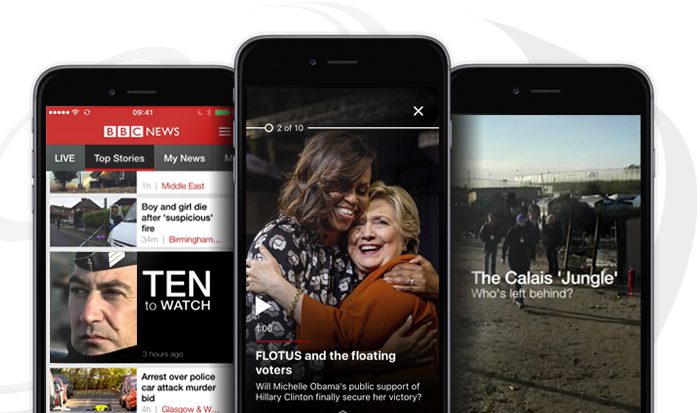
When BBC News began experimenting with vertical video in its main mobile app last year, many staffers were skeptical. But the player’s development has helped “take some new departments into the world of iterative, user-centered design,” in the words of creative director Ryan O’Connor, and results are promising.
In the fall, after internally testing the vertical video in the app, BBC News unveiled a reboot of its main mobile app. Even though just a fraction of the BBC’s audience uses the app, 48 percent of BBC News’ digital video is viewed there, and about a quarter of viewers watch more than five clips weekly. The broadcaster wanted to take steps to make those videos more mobile-friendly and move beyond just repackaging TV stories.
 There are now two modules that play vertical video within the BBC app. “Videos of the Day” is a Snapchat-like playlist of stories that users can swipe through; Monday’s edition covered everything from Meryl Streep’s speech at the Golden Globes to a pair of red pandas playing in the snow. And in December, the BBC debuted the more feature-oriented BBC Stories.
There are now two modules that play vertical video within the BBC app. “Videos of the Day” is a Snapchat-like playlist of stories that users can swipe through; Monday’s edition covered everything from Meryl Streep’s speech at the Golden Globes to a pair of red pandas playing in the snow. And in December, the BBC debuted the more feature-oriented BBC Stories.
It was occasionally tough to get editorial teams on board, said mobile product manager James Metcalfe, since they’d be responsible for creating new types of video content; at the time of the internal tests, “a majority of the pieces that we were producing were still landscape video.” But “from that internal beta, [we saw] that vertical was way better. The switch clicked that we need to produce more packages of content that are in this format.”
“Telling a story in this format makes it more personal,” said O’Connor. “There’s a FaceTime-like quality to the way it frames people…it [allows us to] connect to a story in a different way while appealing to different audiences.”
 The BBC’s vertical video segments are typically 90 seconds or less, and they’re subtitled so viewers can watch without sound. Many of the pieces shared directly on Facebook or other social platforms. The BBC is also developing vertical video ads.
The BBC’s vertical video segments are typically 90 seconds or less, and they’re subtitled so viewers can watch without sound. Many of the pieces shared directly on Facebook or other social platforms. The BBC is also developing vertical video ads.
In previous projects, the digital team was primarily building a product for a pre-determined editorial product. But with the vertical video initiative, the digital staffers also played a hand in determining what the editorial coverage would look like, said head of product Alex Watson.
“This is probably one of our first projects where UX, product, and technology have played an intimate part in shaping the content proposition,” he said.
The BBC launched a public beta in July and tweaked the product as it received feedback from testers. For example, users tended to watch several videos at a time, so the team made sure it was easy to swipe between them.
“Younger audiences, women in particular, are drawn to this approach that is more visual and video,” said O’Connor. “You get audiences telling you that it’s almost a sit-back kind of experience. If people do want to dig deeper, we give them an onward journey, but we’re not going to give you 500 onward journeys. We’re trying to limit that overwhelming feeling of choice that is in the core app experience.”
The BBC wouldn’t share specific viewership figures, but Metcalfe said the addition of vertical video has been well received.
While the addition of vertical video might have seemed seamless to app users, the BBC’s content production system is still primarily designed for television and horizontal output. Often, horizontal videos have to be repurposed for the vertical player.The app launch was “a good example of compromising to get to market and prove” that vertical video can work,” Watson said. “As always, with workflow, there’s this chicken-and-egg situation: People don’t want to change if it’s not real and hitting the front end and being seen by the audience — but of course, if you really want to radically change, you need to change the content before the audience sees it.”
Watson is hopeful that BBC News’ adoption of vertical video will encourage other areas of the BBC to experiment with it.
“Vertical for drama has not happened yet,” Watson said. “But it probably will. What’s nice now that we’ve done it is that there will be a conversation in the wider BBC about vertical video. Certainly, in sport, you’ll start to see it soon.”